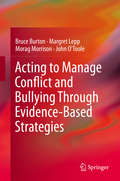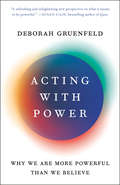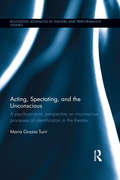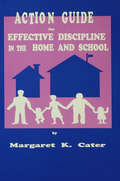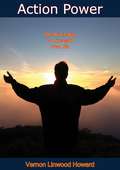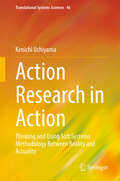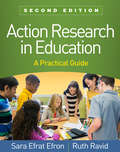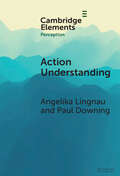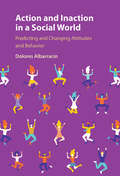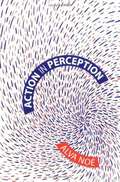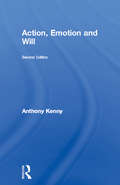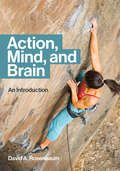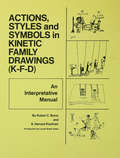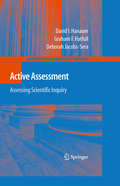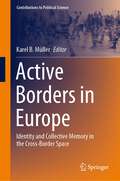- Table View
- List View
Acting Out: A Guide To The Development And Presentation Of Issue-Oriented, Audience- interactive, improvisational theatre
by Jennifer Russell Mario Cossa Sally Ember Lauren GlassThis handbook offers a compilation of background information, techniques and scenarios based on the Acting Out programme that offers theatre skills/counselling for groups of adolescents, free of charge. AO teens become performers, creating issues-oriented, audience-interactive, improvizational scenes with a variety of audiences.; Written for leaders who are familiar with improvizational theatre and working with groups, Part 1 discusses the importance of leader training, experience and intention. Psychodrama, sociodrama and theatre scenework are explained in some detail, with references offered for those who wish to learn more about these areas before proceeding. Information about group selection criteria, procedures and techniques for using the scenarios complete this section.; Part Two offers a set of eight topics each with its own list of scenarios. Each scenario begins with information about characters, settings and situations, and offerrs acting notes as well as age- appropriaeteness. A list of resources appears at the beginning of each thematic set of scenarios.
Acting to Manage Conflict and Bullying Through Evidence-Based Strategies
by Bruce Burton Margret Lepp Morag Morrison John O'TooleThis book offers a complete and detailed account of the evolution of an internationally successful, evidence-based program that has been the result of almost two decades of action research into conflict and bullying. It addresses one of the most serious problems encountered in schools and work places worldwide: that of bullying and inter-personal conflict. The book presents a comprehensive account of the research, development and refinement of the DRACON Project and the Acting Against Bullying and Cooling Conflicts programs. The effective strategies that emerged from the extensive international research and practice use a combination of theories of conflict and bullying management with drama techniques and peer teaching which have been unique in their application. The book analyses their evolution into an effective program that has impacted positively on bullying and conflict in a number of settings. In the UK the program successfully addressed behavioural problems amongst girls in schools through the use of peer teaching in a drama setting. In Sweden the program assists nursing students, nurses and other health professionals to deal with conflict in the workplace. In Australia it has been applied in hundreds of schools to reduce bullying and assist newly arrived refugees to deal with cultural conflict and develop resilience and self- identity in their new country. This volume makes a major and authentic contribution to the international effort to find effective strategies and techniques to deal with interpersonal conflict and bullying across a range of contexts.
Acting with Power: Why We Are More Powerful Than We Believe
by Deborah GruenfeldThere is so much we get wrong about power. This eye-opening look at the true nature of power explores who has it, what it looks like, and the role it plays in our lives.&“A refreshing and enlightening new perspective on what it means to be powerful.&”—Susan Cain, bestselling author of QuietGrounded in over two decades&’ worth of scientific research and inspired by the popular class of the same name at Stanford&’s Graduate School of Business, Acting with Power offers a new and eye-opening paradigm that overturns everything we thought we knew about the nature of power. Although we all feel powerless sometimes, we have more power than we tend to believe. That&’s because power exists in every relationship, by virtue of the roles we play in others&’ lives. But it isn&’t a function of status or hierarchy. Rather, it&’s about how much we are needed, and the degree to which we fulfill our responsibilities. Power isn&’t a tool for self-enhancement or a resource for personal consumption. It&’s a part you play in someone else&’s story. We often assume that power flows to those with the loudest voice or the most commanding presence in the room. But, in fact, true power is often much quieter and more deferential than we realize. Moreover, it&’s not just how much power we have but how we use it that determines how powerful we actually are. Actors aren&’t the only ones who play roles for a living. Like actors, we all make choices about how to use the power that comes with our given circumstances. We aren&’t always cast in the roles we desire—or the ones we feel prepared to play. Some of us struggle to step up and be taken more seriously, while others have trouble standing back and ceding the spotlight. Some of us are used to hearing we are too aggressive, while others are constantly being told we are too nice. Deborah Gruenfeld shows how we can all get more comfortable with power by adopting an actor&’s mindset. We all know what it looks like to use power badly. This book is about how to use power well.
Acting, Spectating and the Unconscious: A psychoanalytic perspective on unconscious mechanisms of identification in spectating and acting in the theatre. (Routledge Advances in Theatre & Performance Studies)
by Maria Grazia TurriFrom Aristotle’s theory of tragic katharsis onwards, theorists of the theatre have long engaged with the question of what spectatorship entails. This question has, directly or indirectly, often been extended to the investigation of acting. Acting, Spectating, and the Unconscious approaches the unconscious aspects of spectatorship and acting afresh. Interweaving psychoanalytic descriptions of processes such as transference, unconscious phantasy, and alpha-function with an in-depth survey of theories of spectating and acting from thinkers such as Brecht, Diderot, Rousseau and Plato, Maria Grazia Turri offers a significant insight into the emotions inherent in both the art of the actor, and the spectator’s experience. A compelling investigation of the unconscious communication between spectators and actors, this volume is a must-read for students and scholars fascinated by theatre spectatorship.
Action As An Organizer of Learning and Development: Volume 33 in the Minnesota Symposium on Child Psychology Series (Minnesota Symposia on Child Psychology Series #Vol. 33)
by Charles A. Nelson John J. Rieser Jeffrey J. LockmanThis is the 33rd volume in the Minnesota Symposium on Child Psychology held in October 2002. The symposium was held to honor the scientific and mentoring contributions of Anne Danielson Pick and Herbert L. Pick, Jr.--two longtime and beloved professors of the Institute of Child Development. It focused on "Action as an Organizer of Learning and Development" and integrated the best and most innovative research on the role of action in perceiving and understanding. Taken together, the book captures the intellectual excitement that characterized the 33rd symposium and appeals to developmental psychologists, particularly those interested in perceptual development.
Action Guide For Effective Discipline In The Home And School
by Margaret K. CaterFirst published in 1992. This Action Guide is for individual or group study of the book Effective Discipline in the Home and School by Genevieve Painter and Ray Corsini. This book assists parents, teachers, and counselors in training children so that home and school will be happy and efficient, organized but pleasant -- with adults satisfied with their children and children growing up to be respectful, responsible, and resourceful. It provides solutions and emphasizes practicality.
Action Methods In Group Psychotherapy: Practical Aspects
by Daniel J. TomasuloFirst published in 1999. Routledge is an imprint of Taylor & Francis, an informa company.
Action Power: The Miracle Way to a Successful New Life
by Vernon Linwood HowardTESTED TECHNIQUES FOR APPLYING CONCENTRATED ACTION POWER TO MAKE MORE MONEY, GET AHEAD FASTER, INFLUENCE PEOPLE, AND GET EVERYTHING YOU WANT OUT OF LIFE—ALMOST MAGICALLY!Discover now how to get what you want in life, by using the miraculous forces of ACTION POWER. Take your first step to a new way of life that will lead to the highest goals of success you most desire.Once the miraculous force of your ACTION POWER is in full operation you will launch out from your current setup and rise like a rocket to new peaks of personal achievement and financial success. You will think success. You will feel success. You will talk success. You will start acting towards success.“Vernon Howard’s Action Power accentuates the positive. The author gives specific directions for improving one’s thinking and actions. It is pleasant and stimulating reading.”—CLYDE F. GILLETT, M.D.“Regardless of whether you want to sell your products to customers or sell yourself a happier life, you now have the amazing key in your hands. A thrilling guide.”—GENE ADAMS, Editor, Specialty Salesman“If you want to get into self-enriching action, start with this great book. Vernon Howard shows you what to do and how to do it—the easy way.”—MARTHA WALKINSHAW, Cook Realty
Action Research and Critical Psychology: An Investigation of Subjectivity and Participation (Theory and History in the Human and Social Sciences)
by Martin DegeThis book examines the theoretical developments in the field of Action Research from a historical perspective. The central focus of the investigation is the concepts of democracy and subjectivity as defined by the field’s various traditions. To address this issue, this book offers a thorough investigation of the theoretical and historical underpinnings of Action Research in order to argue that such a clarification allows for a transcendence of the distinction between theory and practice in political action. This transcendence will be achieved with the theories of the German critical psychologist Klaus Holzkamp and his interpretation of subjectivity and democracy. Holzkamp establishes a comprehensive mode of change based on the contradiction of existing possibilities for action and restrictions in a concretely given empirical situation. This book is aimed at History of Psychology Classes, Social Workers, Activism Researchers, Undergraduate Courses in Critical Thinking and Political Action, and Decolonial Theory in Psychology.
Action Research in Action: Thinking and Using Soft Systems Methodology Between Reality and Actuality (Translational Systems Sciences #46)
by Kenichi UchiyamaThis is the first book to provide the fundamental backbone for the field of action research (AR). One of the main characteristics of AR is to achieve a kind of learning based on experience through action in the real world, connecting and reconciling theory and practice by reflection for / in / by action. A standard form of AR has not yet been found, however, because it is difficult for conventional academicians to effectively bridge the gap between objectivity in theory and subjectivity in practice. For the past 50 years, soft systems methodology (SSM) has developed the methodology to deal with subjectivity by rigorously adhering to a coherent guideline of a systemic means for discussion— for example, accommodation (i.e., living with different individual worldviews). The author began to reinterpret SSM from an Eastern context at Lancaster University (UK), and received a Ph.D. at the London School of Economics, introducing the &“actuality&” point of view. This idea originated with the eminent Japanese psychiatrist Bin Kimura, who argued that schizophrenics do not lose touch with reality but with actuality. That is, there are two aspects of the world, reality and actuality, based on Latin res (&“thing&”) and actio (&“action&”). They can recognize all things of the world as &“reality&” as expressed by that noun but cannot comprehend with a feeling of reality the predicate &“actuality&”. Introducing actuality into SSM as a new dimension opened a new perspective in SSM both theoretically and practically. This topic is discussed in detail in Part II of this book. Part I contains three chapters. Chapter 1 provides a basic conceptual overview of SSM. Chapter 2 provides an actual trace of the evolution of SSM over the last 25 years. One topic that is expected to become the subject of serious practical application of SSM in the future is its application to resilience. This is discussed in some detail in Chapter 3. The actuality aspect of SSM has been used for more than 20 years in various contexts, yielding many good results. Among those are a new explanation of accommodation using paleo logic or predicate logic; a new management cycle based on actuality, such as learning for / in / by action; and the novelty of the methodological tool itself. Those 20 years of learning authenticate the guideline for the way of discussion or agreement that is relevant to actuality. Especially in the recent Covid-19 pandemic, it has oriented the restoration of actuality in the digital-based society, where actuality is deadened. This result is also dealt with in Part I.
Action Research in Education, Second Edition: A Practical Guide
by Sara Efrat Efron Ruth RavidAcclaimed as a text and professional development tool, this user-friendly resource has now been revised and updated, and offers expanded coverage of collaborative action research (CAR) and participatory action research (PAR). Preservice and inservice educators get crucial step-by-step guidance for conducting classroom- and school-based studies to improve their instructional practices. Organized to mirror the full cycle of action research, the book provides balanced coverage of qualitative, quantitative, and mixed methods approaches. Vivid vignettes and examples illustrate research approaches for a range of teaching and learning situations, school subjects, and age groups (PreK–12). Readers learn how research approaches are driven by the research question, as well as how to develop data collection strategies; design and/or evaluate assessment tools; interpret, analyze, report, and implement study results; and design a new cycle of research that builds on the previous one. New to This Edition *In-depth descriptions of CAR and PAR--which enable groups of teachers to work together to solve problems in a classroom or school--plus examples of both throughout the book. *Expanded or new discussions (with examples) of such topics as how research approaches and methods are driven by the research question, how to assess different types of reliability and validity, the differences between analysis and interpretation, and how to use sequential cycles of research for continuous improvement and professional development. *Fully updated references and resources. Pedagogical Features *Both individual and group exercises and activities in every chapter. *New and updated checklists and guidelines that enable busy educators to self-assess the progress and quality of their studies. *Sample templates to assist in development of research instruments. *Example boxes illustrating the components of an action research report. *Summary tables highlighting key aspects of different research strategies. *Chapter summaries (now shorter for ease of use) and suggestions for further reading.
Action Understanding (Elements in Perception)
by Angelika Lingnau Paul DowningThe human ability to effortlessly understand the actions of other people has been the focus of research in cognitive neuroscience for decades. What have we learned about this ability, and what open questions remain? In this Element the authors address these questions by considering the kinds of information an observer may gain when viewing an action. A 'what, how, and why' framing organises evidence and theories about the representations that support classifying an action; how the way an action is performed supports observational learning and inferences about other people; and how an actor's intentions are inferred from her actions. Further evidence shows how brain systems support action understanding, from research inspired by 'mirror neurons' and related concepts. Understanding actions from vision is a multi-faceted process that serves many behavioural goals, and is served by diverse mechanisms and brain systems.
Action and Inaction in a Social World: Predicting and Changing Attitudes and Behavior
by Dolores AlbarracínThis book explains how actions and inactions arise and change in social contexts, including social media and face-to-face communication. Its multidisciplinary perspective covers research from psychology, communication, public health, business studies, and environmental sciences. The reader can use this cutting-edge approach to design and interpret effects of behavioral change interventions as well as replicate the materials and methods implemented to study them. The author provides an organized set of principles that take the reader from the formation of attitudes and goals, to the structure of action and inaction. It also reflects on how cognitive processes explain excesses of action while inaction persists elsewhere. This practical guide summarises the best practices persuasion and behavioral interventions to promote changes in health, consumer, and social behaviors.
Action and Insight
by Paul L. WachtelThe publication of this set of selected papers provides an opportunity to reflect on the compass of this work. It offers me, as well as the reader, the chance to reflect on the main themes and how they interact, and to consider the underlying as¬sumptions that have energized and, inevitably, limited the work. It affords as well a chance to consider the important questions that remain unanswered and how they might be pursued.
Action in Perception
by Alva Noë"Perception is not something that happens to us, or in us," writes Alva Noë. "It is something we do." In Action in Perception, Noë argues that perception and perceptual consciousness depend on capacities for action and thought -- that perception is a kind of thoughtful activity. Touch, not vision, should be our model for perception. Perception is not a process in the brain, but a kind of skillful activity of the body as a whole. We enact our perceptual experience.
Action, Emotion and Will: 1963 Edition
by Anthony Kenny Dr Anthony KennyAction, Emotion and Will was first published in 1963, when it was one of the first books to provoke serious interest in the emotions and philosophy of human action. Almost forty years on, Anthony Kenny's account of action and emotion is still essential reading for anyone interested in these topics.The first part of the book takes an historical look at the emotions in the work of Descartes, Locke and particularly Hume. In the second part, Kenny moves on to discuss some of the experimental work on the emotions by 20th Century psychologists like William James. Separate chapters cover feelings, motives, desire and pleasure. This edition features a brand new preface by the author.
Action, Mind, and Brain: An Introduction
by David A. RosenbaumAn engaging and accessible introduction to the psychology and neuroscience of physical action.This engaging and accessible book offers the first introductory text on the psychology and neuroscience of physical action. Written by a leading researcher in the field, it covers the interplay of action, mind, and brain, showing that many core concepts in philosophy, psychology, neuroscience, and technology grew out of questions about the control of everyday physical actions. It explains action not as a &“one-way street from stimuli to response&” but as a continual perception-action cycle. The informal writing style invites students to think through the evidence step by step, helping them develop general thinking stills as well as learn specific facts. Special emphasis is placed on the role of underrepresented groups. The book discusses the intellectual background of the field, from Plato to Kant, Dewey, and others; applications and methods; and the physical substrates of action—bones, tendons, ligaments, muscles, and nerves. It considers the control of actions in space; learning, and the roles of nature and nurture; feedback; feedforward, or anticipated feedback; and degrees of freedom—the multiple ways of getting things done and three methods for narrowing the alternatives. The book is generously illustrated, including many images of thinkers who contributed to the field.
Action, Perception and the Brain
by Jay SchulkinTheories of brain evolution stress communication and sociality are essential to our capacity to represent objects as intersubjectively accessible. How did we grow as a species to be able to recognize objects as common, as that which can also be seen in much the same way by others? Such constitution of intersubjectively accessible objects is bound up with our flexible and sophisticated capacities for social cognition understanding others and their desires, intentions, emotions, and moods which are crucial to the way human beings live. This book is about contemporary philosophical and neuroscientific perspectives on the relation of action, perception, and cognition as it is lived in embodied and socially embedded experience. This emphasis on embodiment and embeddedness is a change from traditional theories, which focused on isolated, representational, and conceptual cognition. In the new perspectives contained in our book, such 'pure' cognition is thought to be under-girded and interpenetrated by embodied and embedded processes. "
Action, Styles, And Symbols In Kinetic Family Drawings Kfd
by Robert C. Burns S. Harvard KaufmanFirst published in 1972. Routledge is an imprint of Taylor & Francis, an informa company.
Actions, Styles, and Symbols in Kinetic Family Drawings (K-F-D): An Interpretative Manual
by Robert C. Burns S. Harvard KaufmanThis classic text focuses on the features of K-F-D that have emerged after more than 12 years of clinical experience with 10,000 drawings. One-hundred and thirty drawings are reproduced, showing common characteristics of K-F-D figures and the varied actions and symbols that reflect relations between family members. Included are a K-F-D Grid and an Analysis Sheet to assist clinicians in interpreting their own patients' K-F-Ds.
Activate Your Goodness: Transforming The World Through Doing Good
by Shari ArisonActivate Your Goodness is a practical guide for doing good for yourself and others, offering you inspiration for immediate improvement of your own life and the lives of those around you. Author Shari Arison, visionary businesswoman and philanthropist, is candid about her own personal stories and also provides examples from others who have made a difference by thinking, speaking, and doing good. Shari boldly shares her own experiences of living an extraordinary life – as one of the world’s most powerful women and the owner of a business empire that spans the globe – and how she has integrated the power of doing good in all aspects of her life and career. The unexpected and delightful insight that emerges from the book shows that when you find a way to do good for others, you also do good for yourself. This is a book to share with your loved ones and those who are partners in your desire to create a better world for future generations. You may even discover your own connections to make your life joyful beyond measure!
Activating Linguistic and Cultural Diversity in the Language Classroom (Educational Linguistics #55)
by Enrica Piccardo Aline Germain-Rutherford Geoff Lawrence Angelica GalanteThis book challenges the reader to rethink and reimagine what diversity in language education means in transnational societies. Bringing together researchers and practitioners who contributed to the international LINguistic and Cultural DIversity REinvented (LINCDIRE) project, the book examines four pillars of innovation in language education: the Action-oriented approach, Plurilingualism, Indigenous epistemologies and Technology enhanced learning. The book critically discusses plurilingual pedagogical approaches that draw on learners' linguistic and cultural repertoires to encourage and support the dynamic use of languages in curricular innovation. It is a fundamental resource for language teachers, curriculum designers and educational researchers interested in understanding current thinking on the relevance and benefit of a plurilingual paradigm shift for language education in today's societies. More specifically, this book: Examines the development of plurilingualism and the potential of real-life oriented teaching and learning. Explores the concept of plurilingual and pluricultural competence. Focuses on collaboration and reflection from a humanistic tradition. Explores educational technology and explains the limitations and challenges of adopting ready-made tools. Highlights the iterative, design-based research process that informed the development of LINCDIRE’s pedagogical framework and action-oriented scenarios. Introduces practical examples of action-oriented tasks and scenarios, and illustrates the online tool (LITE) in terms of its current functionalities and design. Describes the implementation challenges and opportunities of plurilingual action-oriented tasks and discusses the results of implementation. Finally, the book examines future pedagogical innovation and research directions in order to help readers reflect on the implications of achieving sustainable change in language education.This exciting collection addresses an important question in language education: How can plurilingualism and cultural diversity be harnessed to promote sustainable innovation in language learning and teaching? Readers will find contributions from the diverse authors timely, compelling, and engaging.— Dr. Bonny Norton, FRSC, University Killam Professor, UBC Dept. of Language & Literacy Education, CanadaEmbracing a design-based research framework, this book offers learners and teachers powerful validation and a rich, relatable and inspiring action-oriented approach to holistic, dynamic, mediated, embodied, true-to-life, plurilingual language teaching and learning.— Dr. Elka Todeva, Professor of Applied Linguistics, MATESOL Program / Advanced Seminar in Plurilingual Pedagogy, SIT Graduate Institute, Washington, D.C.Anyone seeking innovation in Language Education will find in this volume a treasure trove of theoretical, empirical and methodological insights to answer the questions that arose among the 25 co-authors’ discussions to rethink language use, language learning, and language teaching.— Dr. Mercedes Bernaus, Emeritus Professor, Universitat Autònoma de Barcelona, SpainThis thought-provoking and timely book argues convincingly for the need to reconceptualize innovation in language education in an increasingly diverse world. —Dr. Regine Hampel, Associate Dean (Research Excellence), Faculty of Wellbeing, Education and Language Studies, The Open University, UK
Active Assessment: Assessing Scientific Inquiry (Mentoring in Academia and Industry #2)
by David I. Hanauer Debbie Jacobs-Sera Graham F. HatfullThe book is designed to provide a theoretical introduction to the field of active assessment, a practical guide to the development of assessment tools for scientific inquiry and a case study of a specific development and implementation process of assessment in a scientific inquiry program. As currently designed the book would have two sections: the first, theoretical and practical developing the concepts of how assessment is developed and implemented and the second section, a case study from research work conducted in the outreach program of the Bacteriophage Institute of Pittsburgh. The book is designed for a wide market of scientists involved in scientific education laboratory work. As with the original research project, this book breaks new ground in the area of scientific education and assessment and at this current time there is no book or research monograph that explicates a serious, comprehensive approach to the assessment of scientific inquiry. It is important to note that according to all the central bodies involved in science education (see the National Research Council's standards for science education) that the use of scientific inquiry is the preferred method of teaching science. Accordingly a book of this type should provide an important service for all active scientific inquiry programs in that it presents for the first time a concept and method for assessing scientific inquiry on the undergraduate and graduate levels. This book could provide an interesting answer to this situation of a required educational context without developed methodologies for evaluation.
Active Borders in Europe: Identity and Collective Memory in the Cross-Border Space (Contributions to Political Science)
by Karel B. MüllerThis book explores how identities, public spheres and collective memories are being transformed in cross-border areas, contributing to the broad sociological context of Europeanization. Offering case studies on the German-Czech-Austrian, and Czech-Polish-German borderlands, the book introduces original primary data on cross-border cooperation. This data is interpreted using the concept of active borders, which approaches borders as a source of multicultural competence and cognitive capacity. In turn, the authors argue that Europeans need to treat borders, both territorial and symbolic, as specific cultural forms. Active borders allow an unprecedented level of cross-border cooperation and integration, and foster a better understanding of differences, rather than re-embedding them or constructing others. Accordingly, the authors contend that active borders promote more dynamic, open and resilient societies, and represent crucial prerequisites for the success of the European integration project.
Active Dreaming: Journeying Beyond Self-Limitation to a Life of Wild Freedom
by Robert MossAs the success of the recent film Inception shows, dreams are a source of perennial fascination. Robert Moss has advanced our understanding of the phenomenon with his visionary and down-to-earth synthesis of contemporary dreamwork and venerable shamanic methods. His “active dreaming” involves re-entering dreams, exploring their possibilities, and directing the subconscious to illuminate and solve problems. He blazes a new trail, guiding readers to use the powers that govern their night dreams to pursue their ideal waking “dream lives.” Based on Moss's decades of teaching, the techniques he shares in these pages are proven, powerful, and even playful. Readers learn to understand and utilize synchronicity, shared dreaming, children's dreams, and healing dreams. The examples Moss shares encourage readers to face fears and tap into dormant power. The result is the freedom to choose — and then revel in — the life of their dreams.

